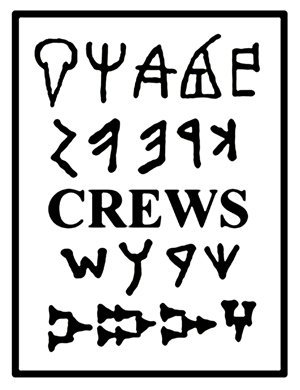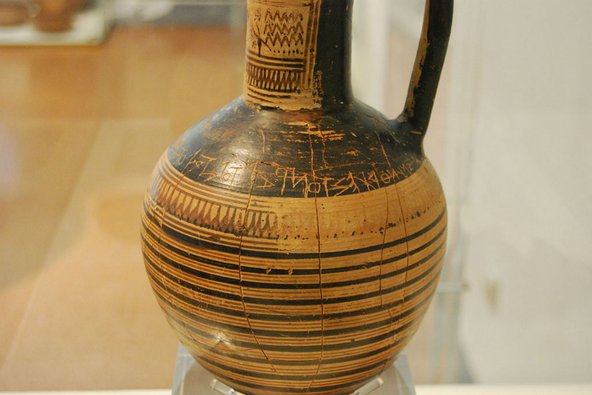Introducing a new international project on ancient writing
by Philippa M. Steele
19 Aug 2016

Between 2012 and March this year I held a British Academy Postdoctoral Fellowship, conducting research on ‘The History of the Greek Language in the Eastern Mediterranean During the First Millennium BC’. At the outset my plan was to look at the development of the Greek language and the contexts in which it was being used in ancient Anatolia, Cyprus and the Levant, from a number of different points of view. What I didn’t realise then was that this research was to open up such a fruitful set of innovative questions that it has now formed the basis for a new and exciting international project.
The new venture is called Contexts of and Relations between Early Writing Systems (CREWS for short), a 5-year project funded by the European Research Council and based in the Faculty of Classics at Cambridge. Its remit is primarily focused on the Eastern Mediterranean and builds strongly on my British Academy research by taking an interdisciplinary approach to writing systems and the populations using them. As Principal Investigator, my own research will be looking at the relationships between the Late Bronze Aegean scripts (Cretan Hieroglyphic, Linear A and Linear B, c.2000-1200 BC), while also working on comparanda such as the development of early alphabetic scripts around Greece, Anatolia and Italy.
Spending the last few years working on Greek in an eastern Mediterranean context has taught me a great deal about how interconnected the ancient world was. ‘Connectivity’ and ‘mobility’ can be judged in so many ways. Sometimes it is the straightforward movement of people from one place to another – but very often it is not so much the movement of people but of ideas that makes the most impact. People traded far and wide, they copied artistic styles from across the sea, they spoke to each other and spread linguistic features in the process, and every cultural encounter of this type left its mark in the material and linguistic remains that we study today.

The CREWS project logo.
The earliest surviving Greek alphabetic inscriptions date from the second half of the 8th century BC and include the vase pictured below that was found in the Dipylon cemetery in Athens. Even at this very early stage, Greek speakers were using the alphabet not only for mundane purposes but also for recording poetry – a novel usage that seems to have been a Greek innovation and was very different from the purposes for which the Phoenicians had been using writing. A similar element of creativity can be found in the development of the writing system itself: the series of letters was adapted so that vowels as well as consonants could be represented, and new signs were created and added on at the end of the alphabetic sequence.

The Dipylon oenochoe. One of the earliest surviving Greek alphabetic inscriptions (running around the body of the vase), second half of the 8th C BC.
So far we have dealt with the standard narrative of how the Greeks borrowed writing from the Phoenicians and created the first ‘true’ alphabet by adding vowel signs – an alphabet that is the direct ancestor of the system we use to write English and many other languages today. But in fact there is something missing from this picture, namely that the Greeks were not alone in these early alphabetic developments.
For example, in Phrygia in central Anatolia, an alphabet very similar to the Greek one was being used – and the earliest evidence for it comes from the 9th century BC, at least 50 years before alphabetic inscriptions written in Greek are attested. Not only does the Phrygian alphabet look like the Greek one visually, but it also crucially shares the innovation of the same set of vowel signs, showing that there must have been a close relationship between the two. It seems clear that the development of alphabetic systems, with signs for both consonants and vowels, was not purely a Greek phenomenon, and here the interconnectedness of the ancient Mediterranean is of central importance. The question is not so much whether the Greeks or the Phrygians borrowed the alphabet first (which has been asked many times to little effect) but how the concept spread and then was appropriated by local groups using it for their own purposes.

On the left, an early Greek alphabetic inscription from Methone reading from right to left ΦΙΛΟΝΟΣ ΕΜΙ (“I belong to Philon”). On the right, an early Phrygian inscription from Gordion reading from left to right ΣΙ↑IΔΟΣΑΚΟΡ (meaning uncertain, possibly with a verbal ending). Both date to the 8th-7th C BC.
This is just one area where the new CREWS project aims to rethink and reanalyse the evidence for early writing systems – looking both at relations (how one system is related to another and how features were borrowed, adapted and innovated) and at contexts (how the people using writing systems and the purposes for which they were using them affected the development of the systems themselves). In the case of early alphabets, for example, it is striking that initially they were being used for very similar purposes (e.g. the recording of names and marking ownership of items) but that local traditions quickly grew up and with them local variations in the alphabetic systems themselves.
Ultimately, the success of the CREWS project will depend on collaboration: a PhD student working on the development of Greek alphabet, and two postdoctoral researchers working on writing systems in the Levant (including Ugaritic and Phoenician), will be joining me in the coming months, and there will be three project conferences and both single and joint volumes and articles arising from it. This seems very fitting for research based on and inspired by the exchange of ideas in the ancient world, and it is gratifying to see that research questions explored under a one-woman project sponsored by the British Academy have gone on to inspire this new ambitious and collaborative project.
You can follow the CREWS project at the project blog here: https://crewsproject.wordpress.com/ or on Twitter: https://twitter.com/crewsproject.
Following a doctorate focusing on the non-Greek languages of ancient Cyprus, Philippa M. Steele has held a Henry Lumley Junior Research Fellowship at Magdalene College, Cambridge, and then a British Academy Postdoctoral Fellowship at the Cambridge Faculty of Classics. Her books include A Linguistic History of Ancient Cyprus (CUP 2013) and Society and Writing in Ancient Cyprus (CUP forthcoming), the latter a publication of her Evans-Pritchard Lectures series given at All Souls College, Oxford, in 2014. She has also edited conference volumes and written numerous articles and book chapters on languages and writing systems of the ancient Mediterranean.
As Principal Invesitigator of the CREWS project, she is now working primarily on the writing systems of Middle-Late Bronze Age Crete and Greece for her project research, as well as other contemporary and later comparanda. She is a Senior Research Associate at the Faculty of Classics, and a Senior Research Fellow at Magdalene College, Cambridge.


